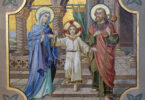
Fwd from Trần Kim Thục
Gospel Jn 20:1-2, 11-18
On the first day of the week,
Mary Magdalene came to the tomb early in the morning,
while it was still dark,
and saw the stone removed from the tomb.
So she ran and went to Simon Peter
and to the other disciple whom Jesus loved, and told them,
“They have taken the Lord from the tomb,
and we don’t know where they put him.”
Mary stayed outside the tomb weeping.
And as she wept, she bent over into the tomb
and saw two angels in white sitting there,
one at the head and one at the feet
where the Body of Jesus had been.
And they said to her, “Woman, why are you weeping?”
She said to them, “They have taken my Lord,
and I don’t know where they laid him.”
When she had said this, she turned around and saw Jesus there,
but did not know it was Jesus.
Jesus said to her, “Woman, why are you weeping?
Whom are you looking for?”
She thought it was the gardener and said to him,
“Sir, if you carried him away,
tell me where you laid him,
and I will take him.”
Jesus said to her, “Mary!”
She turned and said to him in Hebrew,
“Rabbouni,” which means Teacher.
Jesus said to her,
“Stop holding on to me, for I have not yet ascended to the Father.
But go to my brothers and tell them,
‘I am going to my Father and your Father,
to my God and your God.’”
Mary Magdalene went and announced to the disciples,
“I have seen the Lord,”
and then reported what he told her.
Meditation: John 20:1-2, 11-18
Mary! (John 20:16)
When Jesus freed Mary Magdalene from seven demons, he did more than just heal her (Luke 8:2). He changed the entire direction of her life. The man who had made her whole again now became the center of her life. She left her fishing village of Magdala and became one of Jesus’ disciples. She would follow him wherever he went.
Eventually that would lead to the cross. While most of his disciples fled, fearing arrest, Mary chose to stay close to Jesus, no matter the cost. She watched as he gave up his spirit, as he was taken down from the cross, as his beaten body was hurriedly prepared for burial and placed in the tomb. And even then, Mary couldn’t stand to be away from him. The next morning, she hastened to the tomb to anoint him.
But what might Mary have been thinking as she made her way to there? The man I thought was going to save Israel, the man who saved me, has been executed. I staked my life on him. What am I supposed to do now?
In the instant that Jesus said her name, Mary knew that death had not been able to defeat Jesus. He was alive! And so were her hopes and dreams. She had not spent the past few years in vain. Everything she had given up to follow the Lord had been more than worth it. Her life would continue to have meaning and purpose. She would still be Jesus’ disciple, and now she would also proclaim his resurrection.
What is the meaning and purpose of your life? Is it to love and serve Jesus? Mary Magdalene would tell you there is no greater thing you can do. She would tell you that it is worth everything—your time, your possessions, your energy, and even some pleasures in life—to follow him. Because he will always love you. Because he will never leave you. And because his plans for you are always greater than anything you could ever conceive of or imagine.
Someday you will meet the risen Lord face-to-face. He will call you by name, and you will recognize him, just as Mary did, because you staked your life on him.
“Lord, may you always be the center of my life.”
Saint Mary Magdalene
She is called “the Penitent”. St. Mary was given the name ‘Magdalen’ because, though a Jewish girl, she lived in a Gentile town called Magdale, in northern Galilee, and her culture and manners were those of a Gentile. St. Luke records that she was a notorious sinner, and had seven devils removed from her. She was present at Our Lords’ Crucifixion, and with Joanna and Mary, the mother of James and Salome, at Jesus’ empty tomb. Fourteen years after Our Lord’s death, St. Mary was put in a boat by the Jews without sails or oars – along with Sts. Lazarus and Martha, St. Maximin (who baptized her), St. Sidonius (“the man born blind”), her maid Sera, and the body of St. Anne, the mother of the Blessed Virgin. They were sent drifting out to sea and landed on the shores of Southern France, where St. Mary spent the rest of her life as a contemplative in a cave known as Sainte-Baume. She was given the Holy Eucharist daily by angels as her only food, and died when she was 72. St. Mary was transported miraculously, just before she died, to the chapel of St. Maximin, where she received the last sacraments.
Source: The Word Among Us https://wau.org/meditations/current
- Saint and Angels http://www.catholic.org/saints
Views: 0







